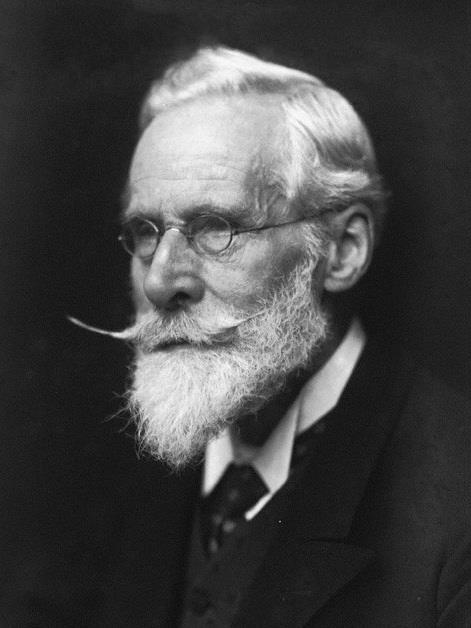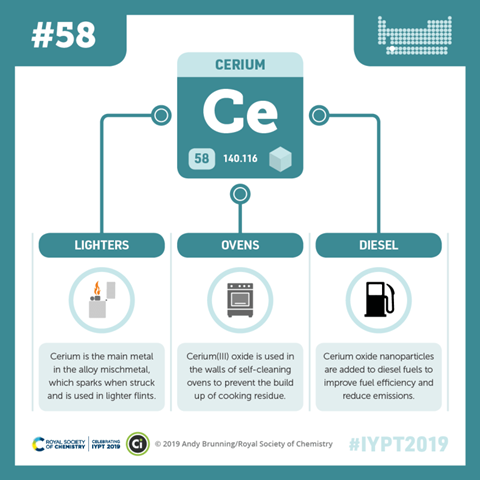Chris Smith
Hello, this week we're meeting the chemical that behaves badly and won't obey the rules when it comes to compounds involving oxygen and if that wasn't inflammatory enough, it is also the source of sparks that brings a lighter to life. But thankfully it's also got a softer side and that is a soothing remedy for burns, as Andrea Sella knows only too well.
Andrea Sella
A few weeks ago I had a stupid accident in the lab; I wont go into the details; I am not terribly proud about what happened. But the result is I suffered from some superficial burns on my face and neck. I was seen to by a specialist nurse who nodded at me and then handed me tub of ointment. 'Its flammacerium', she said, 'apply it twice a day'. 'Flama what', I replied, 'cerium', she said. I was delighted. 'Cerium, it can not be serious, it's my favorite element'. The nurse laughed. Fortunately she didn't ask me why, she would have never got me out of the clinic. But perhaps if she listened to this podcast, she will find out.

Cerium is one of the first members of a series of about 14 elements with exotic and evocative names often referred to as the 'rare earths' or 'lanthanides'. The most striking thing about these elements is their remarkable chemical similarity. So much so for almost a hundred years, chemists almost went mad trying to separate them. William Crookes, the great Victorian inventor and spectroscopist wrote in 1887, 'these elements perplex us in our researches; they baffle us in our speculations and haunt us in our very dreams. They stretch like an unknown sea before us marking mystifying and murmuring strange revelations and possibilities'. Yet Cerium stands out from the crowd with its insoluble ceramic oxide, Ceria which has changed our world. But I'm, getting ahead of myself.
The discovery of Cerium was an accident. Around 1800, a young geologist Wilhelm Hisinger was rock hunting on his father's estate on the island of Västmanland, in Sweden, and found a new mineral that struck him as unusually dense. Hoping that it might be an ore of the recently discovered element tungsten, Hisinger sent a sample to that element's discoverer Carl Wilhelm Scheele who took a look and said rather unhelpfully that there was no Tungsten in it. Undeterred Hisinger went to work with the great Swedish analytical chemist theorist Jöns Jakob Berzelius. In 1803, they isolated a new metallic element that they separated, thanks to the insolubility of its oxide. The named the element after the asteroid Ceres, itself named after the Roman goddess of agriculture. At about the same time, the German analyst Martin Klaproth isolated the same element from a different Scandinavian mineral. Both reports appeared in the same journal a few months apart causing something of an academic clash over exactly who got there first. The isolation of the metal however would have to wait another 70 years until the electrolysis of molten Cerium Chloride.

The metal itself is nothing special to look at; it's a standard silver grey color and it tarnishes slowly in air as an oxide layer builds up on the surface. But in powdered form it is much more exciting. It is highly reactive particularly when alloyed with iron; it forms a brittle material ferrous cerium which sparks spectacularly when struck and is the basis of the flints of cigarette lighters and those exciting fire steels for chefs. Why does it burn so furiously? Well Cerium is fairly electro positive. So it will give up its outer electrons easily. And the oxide Ceria that I alluded to earlier is almost brick like in its stability. So it gives out huge amount of energies when it combusts. Ceria is also very hard which has made it a useful roche or polish for lens. If you happen to want to grind or polish your own telescope, then cerium dioxide is probably what you will use. But what makes the oxide really interesting is it misbehaves. Although the formula may appear to be CeO2, one cerium 2 oxygens in reality the compound always has slightly less than 2 oxygens; the surface is peppered with defects, gaps where an oxygen atom should be and the degree of imperfection varies; it depends very much on how the oxide is prepared or treated. So one of the headline uses for this apparently flawed oxide is in the catalytic converters of cars and trucks. A honeycomb of cerium dioxide helps to combust un-burnt fuel coming down the exhaust pipe by releasing oxygen during the oxygen lean part of the engine's cycle while picking the oxygen back up in the rich stage. As a nanopowder, mixed in with diesel fuel, it can clean up the otherwise sooty fumes produced by trucks and buses. So Cerium is critical for reducing the impact of the internal combustion engines that power our vehicles. But if you take an even closer look at Ceria it becomes more confusing. At first sight it looks like a no-brainer. Cerium looses 4 electrons handing them over to the surrounding oxygen leaving aside defects, this means it has a 4+ oxidation state. But on very close inspection with x-ray spectroscopy its clear that the Cerium hangs on to at least some of those four electrons and its true oxidation state is in a quantum mechanical limbo some where between 3 and 4. Indeed the great Japanese spectroscopist Akio Kotani once wrote that 'there is no genuine example of Cerium 4'. And as always there is mystery concealed just beneath the surface of even the most apparently simple looking chemistry. So why you might ask, is Cerium a burn cream; that too is a mystery. The most that the doctors can tell me is that it seems to work. Something to which I can great fully attest.
Chris Smith
That's UCL's Andrea Sella on Cerium the element that sparks up lighters, vanishes burns and also helps us to clean up our act when it comes to pollution. Now next week it's definitely a case of don't blink, or you might miss it.
Phillip Ball
The nuclear collisions used to make them created only about one atom per hour. Yet 7 fleeting atoms of seaborgium to work with, the researches figured out that it's a metal comparable to molybdenum and tungsten. In such virtuoso experiments we can see the periodic table continuing to exert its pattern even among the elements that nature never glimpsed.
Chris Smith
And Phil Ball will be telling us the story of those 7 atoms of Seaborgium next time. I do hope you can join us. I'm Chris Smith, thanks for listening.













No comments yet